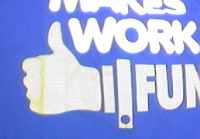Storage Crisis
The latest minor crisis we’re facing at home is that of storage, or the lack thereof. We have 2300 square feet and zero closet space. It’s stressing me out.
It turns out Jenn an I are both sentimental, organized pack rats. We keep things because [we might need it again someday | it could be worth something | it’s been around forever and has sentimental value] (choose one).
The thing is, those arguments don’t hold water for the majority of stuff we have stored.
We have boxes of books that we keep “in case we want to read them again” but they’re such a pain to get to that we’ll never get them out - more likely we’ll just go find a different book to read.
And, honestly, I’ve got two pickaxes in my garage. Two. I don’t think I’ve used one since I’ve moved in, and if I somehow need a pickaxe… well, I think maybe I’ll just go to Home Depot.
Things we figure might be worth something really aren’t. The set of plastic “Disney’s Hercules” plates from McDonald’s that I’ve been carting around for years goes for $10 - $30 on eBay. It’s $10 worth of time and effort just to list the thing for sale and pack it up for shipping if it sells. They’re not worth anything.
The sentimental items are harder to deal with, but there’s low-hanging fruit even in that area. For example, I don’t think we need every random photo we’ve ever taken if we have the negatives anyway and we’re not in them. We got rid of a two-inch stack of pictures this weekend.
Anyway, “the items you own will end up owning you” has started to become a more prevalent theme for me. Overwhelming, too. Whenever I think I should just deal with a box of stuff, I feel like I did in school when it was time to write an essay. Where to begin? Is it even worth it? There are so many other jobs I could do…
Jenn, wonderful as she is, is not much help because a) she’s afflicted by the same pack rat sickness I am and b) if it involves putting up racks or shelves or moving heavy boxes of our crap around, it’s all me, baby. To her credit, she was the one this weekend that went through the box of photos and crap that’s been in our dining room for two years now.
Slowly but surely, we’re going to have to deal with this. For anything that comes into the house, we need to figure out something that’s going to leave.
 My
“fabulous prize” is a t-shirt of dubious manufacture. No brand I’ve
ever heard of. Far too thin to wear without - you guessed it - another
t-shirt underneath. (Hey, not even my wife wants to see my man-boobs
showing through, and I certainly don’t blame her. I wouldn’t want to
see that, either.) Oh, and it’s got this ad on the front for careers at
the company that, frankly, I don’t get. There’s this weird shape that
is a cross between an upside-down speech bubble and the head of a golf
club that I think is supposed to be a hand giving a “thumb’s up” sign,
but I can’t be sure. This weird image thing is intermingled with the
phrase “[Vendor Name] Makes Work FUN.” Ummmm, okay.
My
“fabulous prize” is a t-shirt of dubious manufacture. No brand I’ve
ever heard of. Far too thin to wear without - you guessed it - another
t-shirt underneath. (Hey, not even my wife wants to see my man-boobs
showing through, and I certainly don’t blame her. I wouldn’t want to
see that, either.) Oh, and it’s got this ad on the front for careers at
the company that, frankly, I don’t get. There’s this weird shape that
is a cross between an upside-down speech bubble and the head of a golf
club that I think is supposed to be a hand giving a “thumb’s up” sign,
but I can’t be sure. This weird image thing is intermingled with the
phrase “[Vendor Name] Makes Work FUN.” Ummmm, okay.